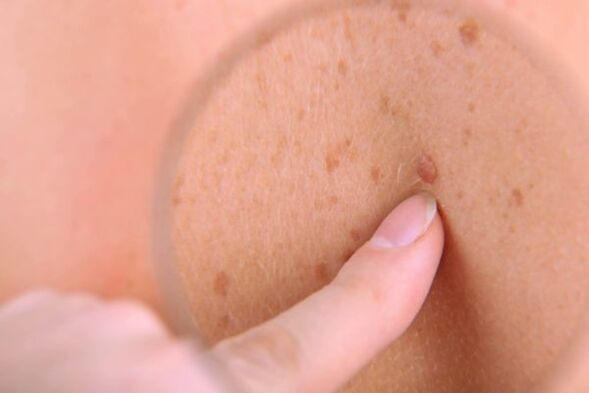The presence of such growths is associated with the presence of HPV in a person. They may not remind you of themselves for a long time.

Reasons for appearance
The cause of warts is papillomavirus, which causes papillomatosis. Such growths on the skin occur if provoking factors are present:
- form of congenital or acquired immunodeficiency;
- stressful situations;
- influence;
- use of cytostatics;
- prolonged use of antibiotics, hormonal and non-steroidal anti-inflammatory drugs;
- chronic form of vitamin deficiency;
- persistent urogenital infections;
- the presence of a herpes virus inside the body.

Attention! The presence of HPV in a person does not guarantee the formation of neoplasms.
Risk subgroups
The papillomavirus is present in the blood of approximately 85% of the population. Many people do not realize that they carry the virus, as HPV is in a latent form and shows no outward signs. People with weakened immune systems due to previous illnesses, pregnancy and diabetes are at risk.
Additionally, those who use drugs that suppress the immune system are prone to infections. Those who frequently change sexual partners are also at high risk.
Routes of infection
There are 3 types of HPV transmission:
- Sexual. It is the most popular method of infection, regardless of the type of sexual intercourse. The virus also spreads through kissing. Penetrating the mucosa of the genital organs, it enters the body through microscopic lesions. The infection can live inside it for a long time.
- Intrapartum. Infection occurs from mother to child during childbirth. At this time, the child may develop warts in the oral cavity and anogenital growths.
- Domestic. It is very rarely spread through contact. It enters the body through microcracks in the skin. This happens when people share personal hygiene items.
But by eliminating these methods of infection it is possible to prevent the onset of the pathology.
Characteristics of papillomas
HPV manifests itself in different ways and has the following characteristics:
- it is found inside the body without the formation of new growths on the skin. In such a situation, the doctor diagnoses a hidden form of pathology. It is possible to detect a pathogen without skin manifestations using PCR;
- they form as growths on the skin in the episomal form of the virus;
- promote the degeneration of epithelial cells from benign to tumorous neoplasms.
What do warts look like?
Warts are inflammatory neoplasms of the skin and mucous membranes. They have the following classification:
- wide with extended base;
- pointed on a thin stem. They often appear on the skin of the genitals and under the armpits. Sometimes it is found at the corners of the mouth.
It is recommended to remove warts in the first stage of their development. Only under such conditions is it possible to eliminate the pathology most likely once and for all. Conservative treatment methods often do not give the expected results.
Symptoms and signs
The symptoms of HPV depend on the underlying cause. The disease has no general clinical symptoms. But the following signs stand out:
- formation of growths;
- skin irritation;
- discomfort during sexual intercourse;
- redness and itching.
Attention! Skin irritation and itching sometimes indicate other pathologies. If such symptoms appear, you should immediately consult a doctor.
Main differences
During external visual examination, as well as when determining the type, many patients, without experience, confuse one type of wart with another. They are divided into two types:
- Papillomas – have a round or thread-like shape with a thin base.
- Warts are irregularly shaped growths. Their irregular outlines usually protrude 0. 5 cm above the skin.
Unlike papillomas, warts often form on the dermis near the genitals, on the labia and foreskin of the penis. They appear darker in color, and their formation confirms the presence of the HPV pathogen in the body.
Diagnostics
The following diagnostic measures are known to identify the type of growths on the skin. These include:
- visual inspection;
- PCR, which allows you to determine the presence of HPV;
- genotyping. An analysis that identifies the type of virus;
- histological diagnosis. It allows you to accurately determine the type of pathology, as well as the probability of malignancy.
Treatment methods
Under no circumstances should you remove warts yourself. Before the growth removal procedure, doctors recommend taking the following measures:
- take antiviral drugs. This helps suppress HPV activity;
- improve the functioning of the immune system - take vitamins and immunomodulators.
Treatment must be prescribed by the attending physician.
Removing the hardware
Skin tumors can be eliminated in the following ways:
- Surgical. Until recently it was the main way to eliminate tumors. After the scab falls off, a scar forms on the affected area. This prompted specialists to look for other methods of excreting growths.
- Chemist. To burn warts, special drugs that contain strong acids are used.
- Cryocoagulation. The growth is frozen using liquid nitrogen at low temperatures. The increased risk of recurrence is a significant disadvantage of using this method.
- Radio waves. It's painless and quick.
- Using a laser. One of the latest means of eliminating skin growths. Not suitable for all warts.
Methods of removing warts directly depend on the severity of the pathology, other diseases, immunity and other factors. Only based on these indicators, the doctor can prescribe a specific method of excision.
Possible complications
If there is no treatment for the pathology, the likelihood of further infections increases, as a result of which the growths can spread to other areas of the skin and quite significantly weaken the functioning of the immune system. Such growths are dangerous because they cause complications:
- formation of papillomas, warts and warts;
- papillomatosis. Extensive growth of neoplasms;
- bleeding. Typically after removal of papilloma hardware;
- infection. During trauma of the neoplasm, the likelihood of infection increases;
- suppuration of neoplasms;
- ulcersFormed due to prolonged friction against clothing;
- precancerous condition;
- cancerous growths inside the body;
- risk of developing skin cancer;
- asphyxia in childhood. When the larynx is affected by papillomas, breathing difficulties often appear. Choking hazard.
Important! Human papillomavirus is a serious disease. It is impossible to ignore it and engage in independent treatment. Otherwise, the disease may worsen.















































































